November / December 2015
Table of Contents
Also see the travel report of my trip to Argentina’s northwest in 2017 where I focused exclusively on the area around Salta including Cafayate, the ruta 40 and Purmamarca.
When I arrived in Buenos Aires I took a ferry that carried me across the river Rio de la Plata to Colonia del Sacramento in Uruguay. There I visited a former work colleague who emigrated to Uruguay. Since my last visit in 2010, he has bought a house that he wanted to show me. He introduced me to some Swiss and Germans who live in Uruguay. Some try to make ends meet with a Bed & Breakfast, others live with the whole family from savings and money from the pension fund. A highlight was a trip to Nueva Helvecia, a town with about 12’000 inhabitants, which was founded in the 1860s mainly by Swiss people. Immigrants were welcome in Uruguay and were able to build their town autonomously. Of course, Uruguay’s first elections took place in Nueva Helvecia. Today’s inhabitants are proud of their origins. The coats of arms of their cantons of origin are to be found in the houses and the Swiss national holiday, 1 August, is celebrated even more intensively than in Switzerland. There is a yodeling club as well as a traditional costume group. Swiss names such as Ettlin, Odermatt, Ackermann or Frey are omnipresent in the little town. The town’s dairy products, especially its cheese, are well known.
As agreed with my colleague, he changed Argentine pesos for me even before I arrived on his last visit to Buenos Aires. I usually get my money from ATMs. In Argentina, however, this was a bad idea, as the so-called blue market rate is more than 50% higher than the official rate used to settle card withdrawals. In the Argentine financial system there were over 10 different exchange rates, e.g. one for Soya exporters or one for tourist services. If one changed US Dollar cash, one received thus much more Peso. But this blue market existed only in a few big cities, so that one had to change large amounts of money on stock, so that the money would last until the next exchange opportunity. The changers were called Arbolitos, trees because they stood around and carried many green leaves, the US dollar notes. I am writing this section in the past because the newly elected President Macri released the peso exchange rate in the first week of his term. The peso immediately depreciated by 35%.
Salta
Then I flew to Salta, the largest city in the northwest of Argentina. Salta is called the beautiful one and is said to have a well preserved old town. The main square is big and is lined by churches and historical buildings. Otherwise I saw many old, not particularly beautiful, one-storey houses. The highlight was the Museo de Arqueología de Alta Montaña, which exhibits for six months one of three children’s mummies that archaeologists had excavated on the summit of the mountain Llullaillaco (6’739 m). These chosen children from the most prestigious Inca families were sacrificed to the gods. They were drugged with alcohol and then buried. They probably died before they regained consciousness. The extreme cold and dryness in the cave on the summit has perfectly preserved the mummies.
Salta – In the former town hall

Humahuaca
After a few days in Salta I traveled north to Humahuaca, from where one could make a tour to a view point. The view to the mountains in many red tones was indeed impressive, especially as it was my first view to these rock formations. Nevertheless, there was no real enthusiasm, as the mountains were far away and one had 30 minutes time before one had to be at the bus again. Since there are other places where you can experience great landscapes without a tour, you don’t need to visit Humahuaca.
Iruya
Afterwards I traveled a few hours by bus over gravel roads and dangerous looking hairpin bends to the small village Iruya, which was at the end of the road. From here it goes only on foot or with a 4×4 vehicle into still more remote villages. The next day I went on a day hike with a Frenchman to one of these villages called San Isidro. On our way we made a detour into a side valley, where we could admire spectacular rock formations in red and green tones, as the photos show.
Iruya – A small village in the north of Argentina

The walk from Iruya to San Isidro



Purmamarca
My next stop was Purmamarca. The landscape here is even more impressive than in the two previous places. Whole mountains shone in the most different red, orange, brown and green tones.
My hotel in Purmamarca

The famous colored rocks of Purmamarca


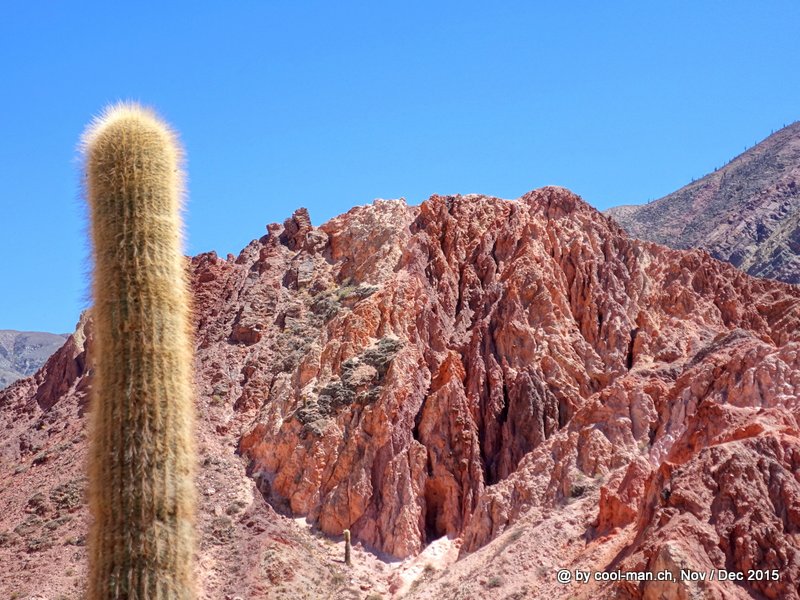



Afterwards I drove back to Salta to stock up with pesos at the Arbolitos.
Cafayate
My next stop was Cafayate 200 km away, a small wine-growing village in a desert area. This place quickly became one of my favorite spot. It is a combination of Arizona with its warm but pleasant climate due to the dryness, Napa Valley with its wineries and good food and Utah with its National Parks and the brightly colored rock formations. Finally I spent 2.5 weeks all in all in this small town. It lies at 1’680 meters between two Andes valleys, so that the air is already dry when flowing over the area. Only in December / January it rains about 20 days. Thanks to the water from the Andes, viticulture is possible despite the desert climate. Since the weather is very stable throughout the year, there are hardly any differences between the vintages, as is usual in Europe. Thanks to the dry air, the grapes are less susceptible to pests. Some wineries therefore produce organically. In the upper part of the valley is the Bodega Colome of the Swiss Hess family, which includes the highest commercial vineyard in the world at over 3,000 metres. At this altitude, the UV rays are stronger and the temperature differences between day and night are greater. The Malbec grapes therefore develop a thicker skin as protection, so that the wines are very intensely colored red and contain many tannins which do not predominate. The bodega has a wine made from grapes only from this vineyard on offer, which I could drink – a very intense experience!
A vineyard in Cafayate

Cafayate is home to wines not found in Europe or even in the rest of Argentina. I love the white wines from the Argentine grape variety Torrontes. It produces aromatic wines with peach and apricot taste and little acidity. With the red wines I noticed the grape variety Tannat, which originates from southwest France. It produces very tannin-rich wines, which I love.
Piatelli winery and restaurant
Where good wine is produced, you usually find good restaurants. My favorite was the restaurant at the Piatelli Winery, where a 5-course Michelin-style menu and wine accompaniment to every course was offered for USD 40. In Switzerland the wine would already cost more. No wonder I stayed so long in Cafayate! The restaurant on the winery El Esteco was my second favorite and in third place was the restaurant of the Bodega Nanni.
The restaurant at the winery Piatelli is the best in Cafayate.

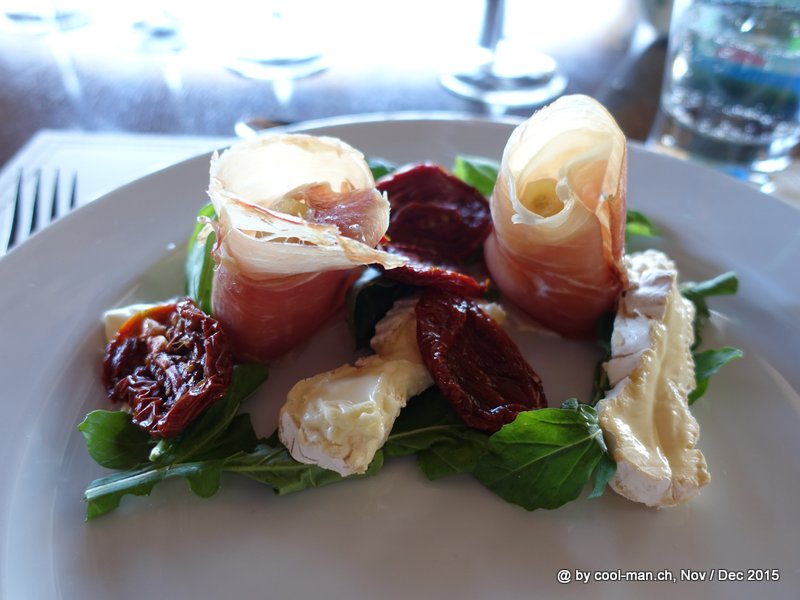
El Esteco winery and restaurant
… and the second best is at the winery El Esteco

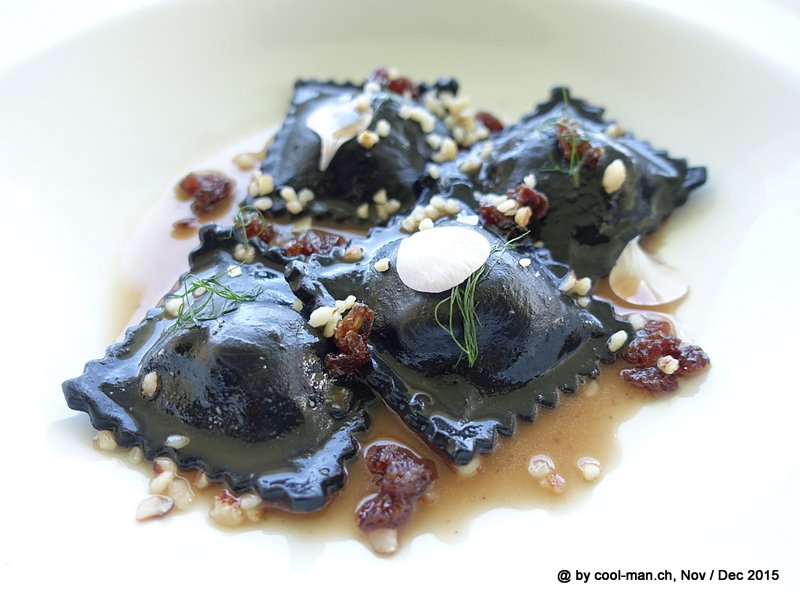
From Cafayate I also made some hikes. In one valley green plants grew, because a stream flowed through the valley and formed waterfalls and swimming pools. Another valley was covered with cacti.
From the passage with the bus I knew that approximately 40 km before Cafayate a breathtaking landscape with bizarre rock formations began and extended over 20 km in the direction of Cafayate, the so-called Quebrada de Cafayate. I took part in a tour to get an impression of this area and to mark some points via GPS, so that I could come back later alone for taking pictures. On a tour I have too little time and freedom to shoot the photos as I wanted. The area was too far away to be reached by bike in a day trip and at the same time to go hiking. So from the beginning it was my plan to rent a car. In Salta I was told that I could rent a car in Cafayate. Unfortunately there was no car rental in this small village. So I decided to take the bus back to Salta, change money, stay overnight and rent the car in Salta the next day.
With the car I drove on a gravel road over the 3’347 meters high pass Piedra del Molino. The view should be impressive. Unfortunately I drove most of the time in the fog and could only see oncoming vehicles at a distance of a few meters.
Cardones National Park
On the other side of the pass one drives through the Cardones National Park. Countless cacti of all sizes are distributed on a plateau. The background forms a red-yellow hill range.
Parque Nacional Los Cardones near Cachi

Cactus Flowers


Cachi
In the small village of Cachi I lived in a bed & breakfast of a young couple from Buenos Aires who fell in love with the seclusion of Cachi and beautifully renovated the dilapidated house. It would have fitted in with the ” Beautiful Living ” magazines that circulated in the salon. One day I discovered the surroundings of Cachi by car and the other day I paid another visit to Cardones National Park.
The cemetery of Cachi

Nothing grows without irrigation. Water is directed to the fields.

Cachi to Cafayate on the Ruta 40
A highlight of my trip was the journey from Cachi to Cafayate on the Ruta 40, one of the dream roads of the world. The Ruta 40 leads from Patagonia in the very south of Argentina over more than 5’000 km to the Bolivian border. Between Cachi and Cafayate the road was a winding gravel road, which was hardly driven on and partly even only single-lane built. Although the distance is 161 km long, the driving time amounted to more than 6 hours. As the photos show, the road led through great landscapes. Each kilometer was marked with a sign. But the sign for kilometer 4’444 was missing. Somebody must have dismantled it. Since so few cars are on the road, all road users greeted each other. Even the construction workers waved.
On the Ruta 40, one of the dream roads of the world

On the Ruta 40 at km 4’413

From this road there was a junction to the Colome vineyard, which operates the world’s highest vineyard. However, it is so remote that you had to drive 40 minutes in one direction from the junction and then back again for so long. I did without it, because the day trip already lasted long enough. And I also have to save something for the next trip when I visited the Colome winery.
Gorge of Cafayate (Quebrada de Cafayate)
In Cafayate I could now discover the Quebrada de Cafayate more thoroughly by car. I parked the car at the roadside and walked through the beautiful landscapes.
Red rocks in the Cafayate gorge








Evening ambiance in the valley of the Las Conchas river

After three days I drove back to Salta by car, changed money again and returned the car. The next morning I was on my way by bus to Cafayate again, where I stayed a few more days. When the Piatelli restaurant closed for renovation, I knew that the time had come for me to leave. The only southern bus destination was San Miguel de Tucuman, a dirty and stinky city 230 km away from Cafayate. After all, one could make an excursion to a nearby hill where there was a waterfall with a bathing pond.
Waterfall of San Javier
The waterfall of San Javier near San Miguel de Tucuman. I like all the greens.

Ischigualasto National Park
On my journey south I came next to La Rioja. With my investigations I noticed soon that I could see the sights of this province best with a rented car. After a trip to the Valle Fertil I visited the Ischigualasto National Park which is a UNESCO World Heritage Site. Here some of the oldest dinosaurs were found. The park protects a desert-like landscape with rock formations created by erosion, which often resemble objects, for example a submarine, a bowling alley or a mushroom. At the end of the tour there was a kilometre-long fire-red wall that would glow at sunset. Unfortunately, the sun was covered by clouds, so that I had to do without this spectacle.
In the Parque Provincial Ischigualasto

The Submarine Rock

Talampaya National Park
Adjacent to the Ischigualasto Park is the Talampaya National Park, which can only be visited with a guided group. We visited an impressive canyon of red rock that has been inhabited by indigenous people for thousands of years. Rock paintings gave a small insight into this long past life.
In the Talampaya National Park

Laguna Brava
The next day I drove by rental car to the 4’200 meter high Laguna Brava. For the 186 km I needed 3.5 hours, because I had to overcome 3’000 height meters and over 50 km I drove on gravel roads, of it more than 30 km on the last, steep section. As the photos show, the way there and the laguna itself with the flamingo colony was probably the highlight of my trip to Argentina. I drove through dream landscapes in all possible colors, which were populated by Guanacos. Guanacos are wild camellias from which the Alpaca was bred. Arrived at the Laguna, a cold wind blew over the plateau. The last 50 km I had not met any car. Only once I saw from afar an army jeep. With a car breakdown I probably would have had to spend the night in the car. I had enough water, food, warm clothes and a flashlight with me. Fortunately there was no emergency. Breathing was difficult because of the height. The group of flamingos was used to the cold and the wind and was not disturbed by me. It was a great experience to be able to observe the flamingos in this breathtaking landscape without any other tourists.
On the way from Villa Union to Laguna Brava at 4’200 m above sea level.


A group of guanacos in a fairytale landscape

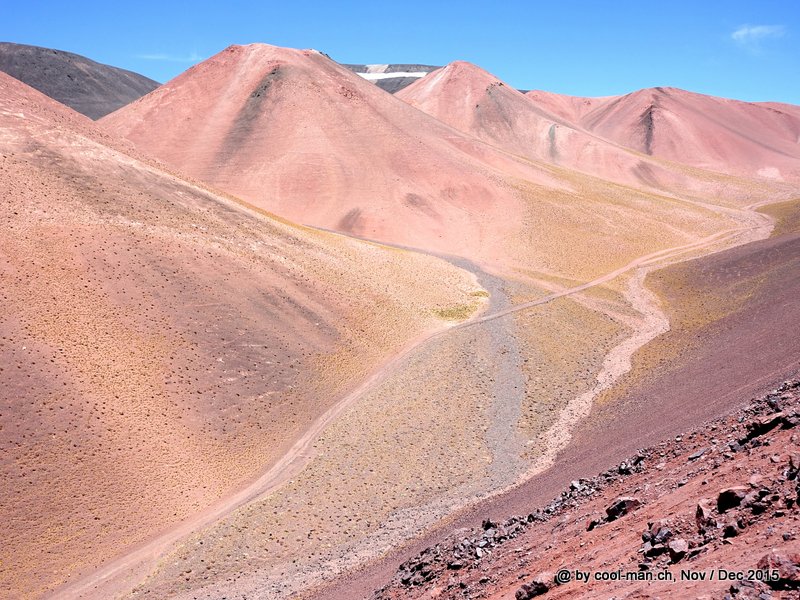


… and finally the Laguna Brava



Chilecito
The next day I drove over an impressive landscape to Chilecito. At this place I visited a more than 100 years old cable car, which broke several records. At its time it was with 35 km the longest in the world and also the one with the highest mountain station, at 4’600 meters. Still today it holds the record of the highest altitude difference of 3’528 meters. It was built to transport gold, silver and copper from the Mina la Mejicana mine to Chilecito, from where there was a railway connection to Buenos Aires. Nine intermediate stations equipped with steam engines were necessary to generate the necessary energy. The cable car and the stations are still completely preserved and are now protected as industrial monuments. Even the rusty steel cables are still stretched over the masts.
The Chilecito cable car transported gold, silver and copper, which were mined at 4,600 metres above sea level. It was 35 km long and was powered by nine stations with steam engines.

Mendoza
Mendoza was my last stop on my trip in Argentina. With hundreds of wineries, the region is the largest wine producer in South America. Partly I rented a bicycle to visit the wineries. Also in Mendoza I found very good restaurants. Everything seemed to run perfectly until fate struck in the form of a hotel maid. On Christmas day a temp cleaned my room. She regarded my two plastic bags filled with many things as rubbish without further ado. Unfortunately, I didn’t notice the loss until the next day, when the hotel had already disposed of the garbage. The hotel owner Emilia was very embarrassed by the incident. She helped me to replace the things as far as possible. Certain things like the Swiss Army Knife were much more expensive in Mendoza than in Switzerland. The power cord to my razor was the only important thing that wasn’t available in Mendoza. In Santiago de Chile I could then find the cable.
Mendoza at the foot of the Andes is Argentina’s largest wine-growing region.
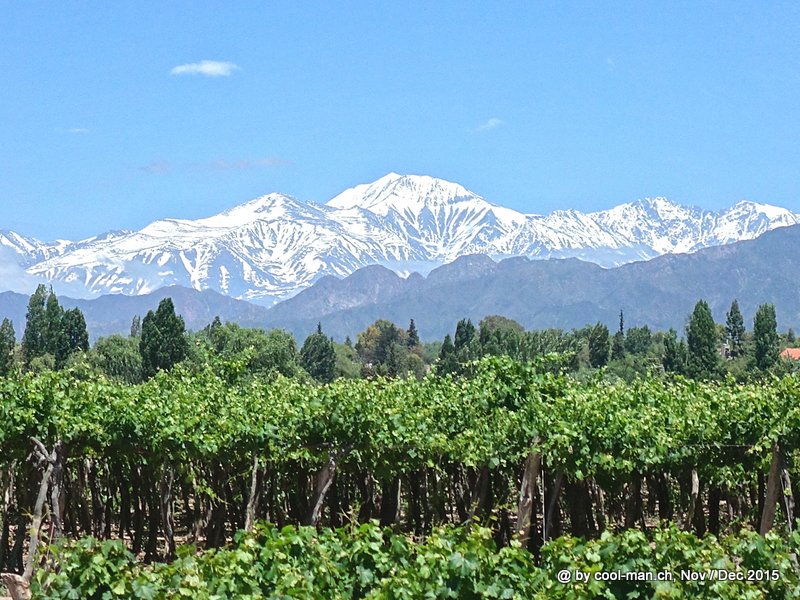
Everyday is barbecue day

Alta Vista produces excellent wines

After a week in Santiago, where I visited the best restaurant in Chile, Borago (No. 2 in South America), I continued to Lima, the gourmet capital of South America. The two restaurants Central (no. 1) and Astrid y Gastón (no. 3) are on the program. I also have to take care of the visa for the Philippines. This country will be my next destination.